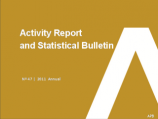APB Activity Report
3rd September, 2012
The Activity Report and Statistical Bulletin (2011) of the Associação Portuguesa de Bancos (APB - the Portuguese Banking Association) are now being published. These documents analyse data on 33 of the 36 financial institutions that the APB represents.
Activity Report 2011
Statistical Bulletin
In 2011, the member institutions operated in a particularly difficult macroeconomic and financial framework. This scenario also involved new demands on the banking sector on the part of the authorities. They included an increase in the minimum core Tier 1 capital ratio to 9% and 10%, by the end of 2011 and 2012, respectively and a reduction in the transformation ratio to 120% by December 2014. They also entailed inspections to assess credit portfolios as at 30 June 2011 as part of the Banco de Portugal Special Inspection Programme (SIP) for the eight largest banking groups and a review of the system for the reorganisation and winding-up of financial institutions set out in the General Regime on Credit Institutions and Financial Companies in order to strengthen bank recovery and resolution mechanisms.
The following data on APB member institutions are particularly important:
- There was a reduction in the transformation ratio from 152.2% in 2010 to 139% in 2011, which was due to a drop in gross credit to customers (-8.1 billion euros or -2.8%) and an increase in customer funds and other loans (+14.1 billion euros or +7.4%).
- The member institutions' funding structure became more stable, thanks to substantial increases in long-term deposits from customers and participation in long-term ECB refinancing operations. The ECB was used almost entirely to reduce balances from other, short-term operations, a practice that began in the second half of 2011.
- There was a pre-tax loss of 1.9 billion euros in 2011, corresponding to a return on equity (ROE) of -7.53%, as opposed to 3.85% the year before. Nonetheless, if we excluded the extraordinary impacts of around 1.9 billion euros in 2011, net income before tax would be -63 million euros, resulting in an ROE of practically zero. These impacts were mainly due to the partial transfer of the banks' pension funds to the Portuguese State, recognition of additional credit impairments resulting from the SIP, a haircut of the Greek sovereign debt and a bank tax (“levy on the banking sector”).
- The core Tier 1 ratio in 2011 was 9.4%, which was higher than in 2010 (8.1%), reflecting a substantial effort by the financial institutions to meet supervision requirements.
- The branch network decreased by 152 units after several years of expansion. There were 6,080 branches in the country at the end of 2011.
- The total number of employees went down around 2.2% in 2011 to 57,130 at the end of the year. This was essentially due to cost-cutting policies.


